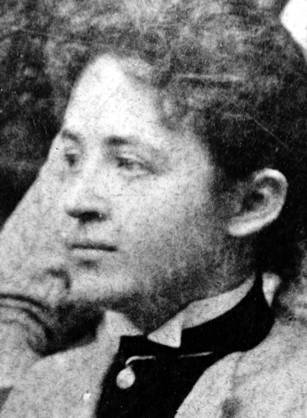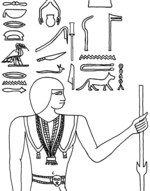
In ancient Egyptian religion, Apis or Hapis, alternatively spelled Hapi-ankh, was a sacred bull or multiple sacred bulls worshiped in the Memphis region, identified as the son of Hathor, a primary deity in the pantheon of ancient Egypt. Initially, he was assigned a significant role in her worship, being sacrificed and reborn. Later, Apis also served as an intermediary between humans and other powerful deities.

Meretseger was a Theban cobra-goddess in ancient Egyptian religion, in charge with guarding and protecting the vast Theban Necropolis — on the west bank of the Nile, in front of Thebes — and especially the heavily guarded Valley of the Kings. Her cult was typical of the New Kingdom of Egypt.

Agnodice or Agnodike is a legendary figure credited as the first female midwife or physician in ancient Athens. Her story is told by the Roman author Gaius Julius Hyginus in his Fabulae. Agnodice is not generally believed to be a historical figure, but her story has been deployed in support of and in opposition to women practicing midwifery or medicine.

Deir el-Medina, or Dayr al-Madīnah, is an ancient Egyptian workmen's village which was home to the artisans who worked on the tombs in the Valley of the Kings during the 18th to 20th Dynasties of the New Kingdom of Egypt The settlement's ancient name was Setmaat, and the workmen who lived there were called "Servants in the Place of Truth". During the Christian era, the temple of Hathor was converted into a Monastery of Saint Isidorus the Martyr from which the Egyptian Arabic name Deir el-Medina is derived.

Female hysteria was once a common medical diagnosis for women. It was described as exhibiting a wide array of symptoms, including anxiety, shortness of breath, fainting, nervousness, sexual desire, insomnia, fluid retention, heaviness in the abdomen, irritability, loss of appetite for food or sex, even sexually forward behavior, and a "tendency to cause trouble for others". It is no longer recognized by medical authorities as a medical disorder. Its diagnosis and treatment were routine for hundreds of years in Western Europe.
Peseshet, who lived under the Fourth Dynasty of ancient Egypt, is often credited with being the earliest known female physician in history. Some have credited Merit-Ptah with being the first female physician, but she is likely a fictional creation based upon Peseshet. Peseshet’s relevant title was "lady overseer of the female physicians," but whether she was a physician herself is uncertain. She also had the titles king's acquaintance, and overseer of funerary-priests of the king's mother.
The role of women in Egypt has changed throughout history, from ancient to modern times. From the earliest preserved archaeological records, Egyptian women were considered equal to men in Egyptian society, regardless of marital status.

Kate Campbell Hurd-Mead was a pioneering feminist and obstetrician who promoted the role of women in medicine. She wrote A History of Women in Medicine: From the Earliest of Times to the Beginning of the Nineteenth Century in 1938. She was born in Danville, Quebec, Canada, and died in Haddam, Connecticut, United States.
Khentetka or Khentetenka was a Queen of Egypt; the wife of King Djedefre during the 4th Dynasty.

Isetnofret was a royal woman of Ancient Egypt and, as the Great Royal Wife of Pharaoh Merenptah, she became Isetnofret II.

Nawal Elsaadawi was an Egyptian feminist writer, activist and physician. She wrote numerous books on the subject of women in Islam, focusing on the practice of female genital mutilation in her society. She was described as "the Simone de Beauvoir of the Arab World", and as "Egypt's most radical woman".
Aemilia Hilaria was a Gallo-Roman physician. She practiced medicine, and wrote books on gynecology and obstetrics. She was called "Hilaria" due to her cheerfulness as a baby.

Ashayet or Ashait was an ancient Egyptian queen consort, a wife of Mentuhotep II in the 11th Dynasty. Her tomb (DBXI.17) and small decorated chapel were found in Mentuhotep II's Deir el-Bahari temple complex. The shrine and burial to Ashayet was found along with the tombs of four other women in their twenties and a young girl, Henhenet, Kawit, Kemsit, Sadeh and Mayet. However, it is likely that there were three other additional shrines that were destroyed in the expansions of Mentuhotep II's burial complex. The nine shrines were built in the First Intermediate Period, prior to Mentuhotep II's reunification of Egypt. She and three other women of the six bore queenly titles, and most of them were Priestesses of Hathor. The location of their burial is significant to their titles as Priestesses of Hathor as the cliffs of Deir el-Bahri were sacred to Hathor from the Old Kingdom onwards.
Adelberger of Lombardy was among several lay medical women who was taught by the historian Paul of Lombardy (720–800), a Benedictine monk from Como. Adelberger was the daughter of Desiderius. Very little information about Adelberger survives today.
Leoparda was a gynecologist who served in the court of Gratian (359–383).
Neferitatjanen was the wife of Amenemhat I, the king of the 12th Dynasty in ancient Egypt, and the mother of Senwosret I. The documentation of her relationships is preserved on a statuette depicting her son.

Bertha Van Hoosen was an American surgeon devoted to women's health issues and the advancement of fellow women surgeons. Among other notable achievements, Van Hoosen was the first president and a founder of the American Medical Women's Association in 1915 and the first woman to be head of a medical division at a coeducational university. She published an autobiography detailing her personal experiences in medicine, Petticoat Surgeon.
The Evening Dispensary for Working Women and Girls was an innovative American health care service at the turn of the twentieth century. As a public dispensary, it provided "outpatient medical treatment and advice to patients, in contrast to the inpatient service provided by hospitals". It offered medical treatment for poor women, educated the public on health matters, and provided female medical students with an opportunity to learn and gain experience.

Lilian Welsh was an American physician, educator, suffragist, and advocate for women's health. She was on the faculty at Woman's College of Baltimore and an active member of National American Woman Suffrage Association. Welsh was posthumously inducted into the Maryland Women's Hall of Fame in 2017.












